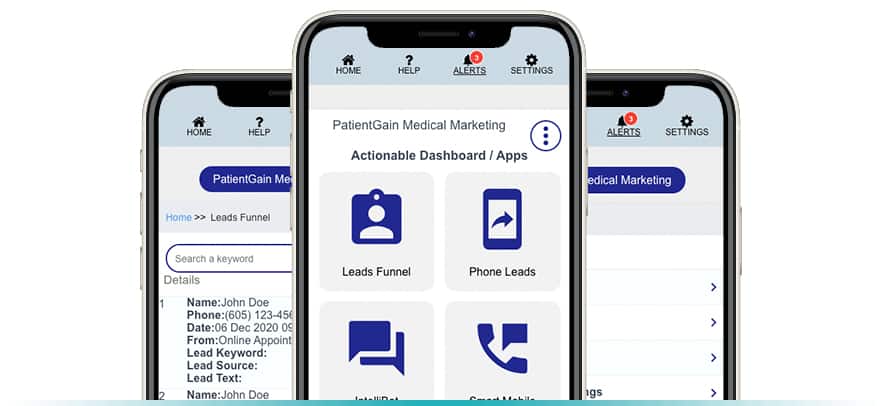Medical Marketing Funnel for Healthcare Practices & How Does It Benefit My Practice? Cost $299/mon
As a healthcare practice owner, you know that marketing is a crucial part of your business’s success and growth. An owner with some marketing experience may have heard of the terms like content marketing and search engine marketing. For example, just think – when you you acquire a new patient, it is added to your EMR ( Electronic Medical Records) however, where do you keep the information about a prospect patient, before they become a patient? 98% of the healthcare practices have no way of securely (per HIPAA) saving information about prospect patients. This is where Patient Marketing CRM or Healthcare marketing Funnel comes into the picture. AI Intelli*Connect Leads Funnel App Costs $299/mon and we will even install it for your practice website, if you use WordPress. For new customers, there is 6 month trial option, which is $99/mon for 6 months. This is so you can check it out. For existing customers it is free and included in the PLATINUM service.
Example 1: A medical weight loss practice simply adds the Intelli*Connect Leads Funnel App to their existing website

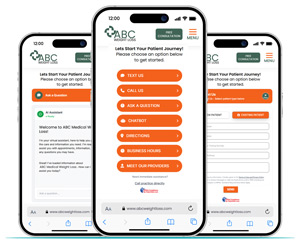
Example 2: This medical weight loss practice has now access a complete marketing funnel app available in a secure HIPAA compliant dashboard. The staff simply logs into the dashboard, and manages and replies to any leads, or existing patient inquiries
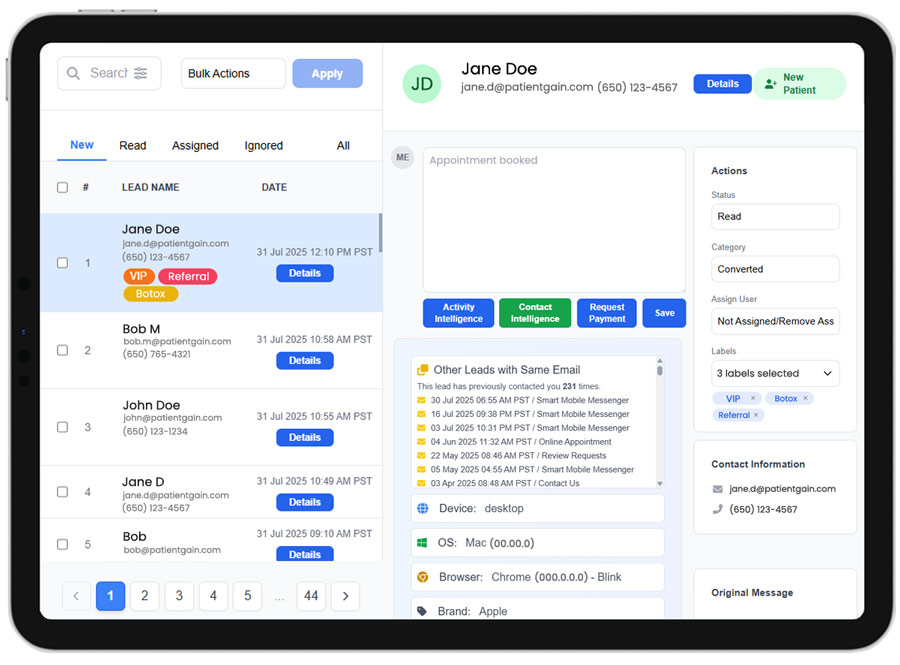
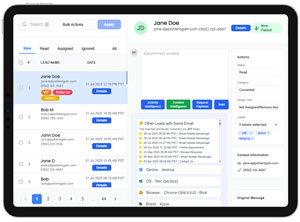
Key results and outcomes of using Intelli*Connect Leads Funnel App
- Increased conversion rates: The AI engine continuously optimizes the lead-capture process and provides a seamless visitor experience, which leads to higher conversion rates for the practice.
- Cost savings: By replacing several single-purpose applications (like call trackers and online booking apps) with a single, integrated solution, practices can significantly reduce their software costs. PatientGain calculates its platform can save a clinic over $18,000 per year by reducing opportunity costs from wasted staff time, duplicate apps, and redundant tasks.
- Improved staff efficiency: Automating routine tasks, such as answering FAQs and initial inquiries, frees up staff to focus on more complex patient needs.
- Enhanced data accuracy: The platform helps maintain a real-time leads repository (CRM) for potential patients who show interest but have not yet converted.
Primary benefits of Intelli*Connect Leads Funnel App
- Centralized lead management: All patient inquiries—from phone calls, texts, website forms, and chatbots—are consolidated into a single HIPAA-compliant dashboard. This simplifies lead tracking and follow-up.
- Automated and intelligent communication:
- 24/7 Virtual Assistant: AI-powered agents provide instant responses to patient questions even when the office is closed, improving overall patient satisfaction.
- Automated follow-up: The system can initiate automated communication to nurture prospective patients and ensure prompt responses.
- Enhanced patient experience: The platform provides a more convenient and modern experience for patients through features like:
- Secure text messaging (SMS): Patients can securely and privately communicate with the practice via text.
- Online tools: Features like checking insurance coverage and asking questions directly from the website increase visitor engagement and conversion.
- HIPAA compliance: PatientGain stores all communication and data handling on its platform are secure and compliant with HIPAA regulations, protecting both the practice and patient information.
- Simplified operations: The integrated system reduces the complexity of managing multiple, non-integrated marketing and communication tools. This streamlines the entire patient acquisition process, from first contact to appointment booking.
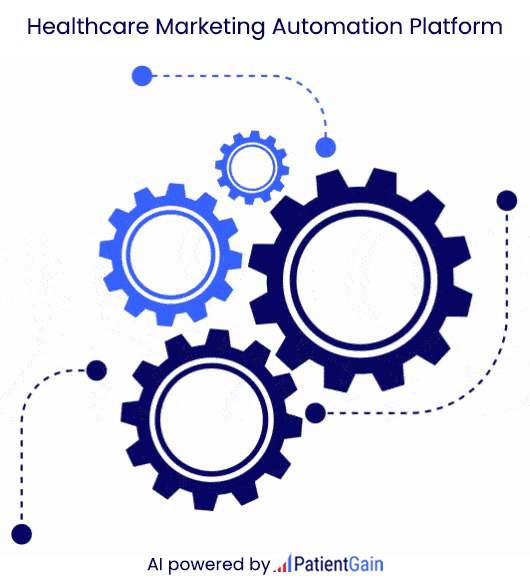
Only the genuinely savvy healthcare owners are aware of the concept called Medical Marketing Funnel. It is a common marketing tool that many healthcare practices are using to drive patients through the door and convert them into long term, loyal patients. The experts at PatientGain.com can help you develop and fine tune your funnel marketing strategies to make them work for you and your business!

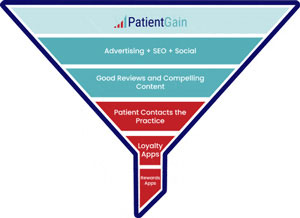
What is healthcare funnel marketing?
Funnel marketing is the journey a patient takes from first being aware of your medical practice to finally become a patient. In other business areas, such as retail, this can sometimes be known as a sales funnel or a conversion funnel. So why is it called or shaped like a funnel? It is shaped like a funnel because the number of people that eventually convert and become patients will be far smaller than the number of people who begin their journey. In other words, if 100 people visit your website for the first time, you should not expect all 100 of those people to become patients eventually. You will lose people along every step of the journey. If you visualize this smaller and smaller pool of potential patients, it begins to look like a funnel.
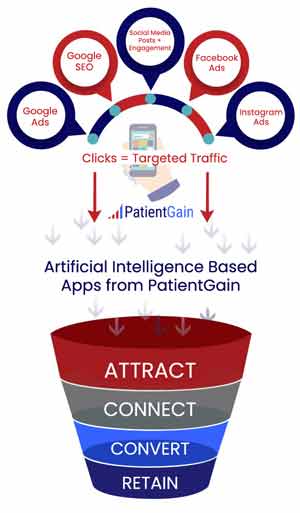
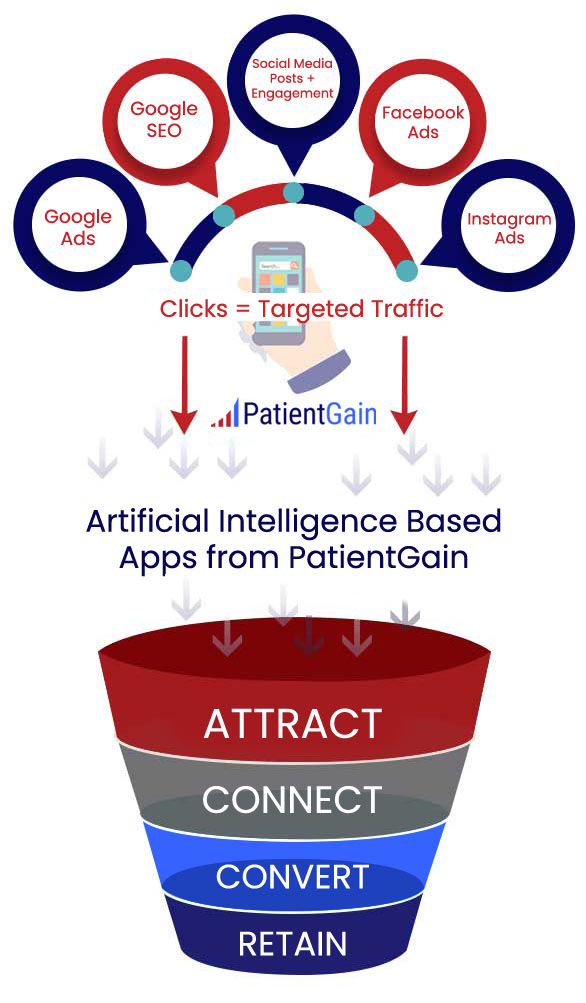
What should a marketing funnel look like for a healthcare practice?
To wrap your mind around the concept of funnel marketing, it is best to divide it up into parts. Each segmented stage of a marketing funnel for a healthcare practice has different elements designed for that specific part. You can generally divide a marketing funnel into three parts: Top, Middle, and Bottom. Each section has a priority:
• Top Funnel Stage – Here, the goal is to bring awareness of your healthcare practice to potential patients and make the first contact with them.
• Middle Funnel Stage – During the middle stage, nurture your patients to get them more familiar with your practice and educate them on the services you offer
• Bottom Funnel Stage – Finally, a potential patient is converted into a long term, loyal patient to your practice
What is the key to getting potential patients started in a healthcare marketing funnel?
A marketing funnel is useless if you cannot get people to begin their journey. The most critical factor in bringing potent patients to your healthcare practice is the content. The higher quality and unique content you have on your website, the more likely you will attract high-quality leads. With that said, many healthcare practices struggle to produce content that is engaging to people. Their content may be the right length, have all the appropriate keywords, be uniquely written, and rank high in organic results, but for some reason can not convert website visitors into patients.
The content might be doing all the right things to satisfy search engines, but it may not be engaging potential patients enough to move them along the marketing funnel. The content on a healthcare practice’s websites all needs to be unique, have enough length, and contain target keywords. Many healthcare practices fail to align their content with the needs of a patient in their journey along a marketing funnel. While it may seem rather obvious, the two don’t precisely automatically go hand in hand together.
With that said, aligning all of your content to serve your marketing funnel can be difficult. In doing so, many healthcare marketers end up with content that is too promotional. A balance needs to be struck because if you do nothing but promote your services, it will not be very attractive to your healthcare practice’s target audience. The content needs to guide potential patients further along in the marketing funnel without spoiling their experience on your website. This balance is challenging to master, but your marketing funnel will perform much better if you strike the right tone.
What is an excellent way to map out a patient’s journey through your marketing funnel?
The task of creating content that aligns with your marketing needs and the needs of potential patients can be seemingly monumental. However, if you sit down and map out your funnel and approach it bit by bit, you will be able to generate content that meets your needs. When writing content, it should be aligned to these categories:
• Awareness
• Consideration
• Conversion
• Retention
“Awareness” and “Retention” are obviously at the “top” and “bottom” of your marketing funnel. “Consideration” and “Conversion” are generally groups together in the “middle” section of your funnel. However, some healthcare marketers will group these two in different parts of the funnel depending on their content nature. Others have “Consideration” straddle the top and middle and “Conversation” straddle the middle and bottom. The point is, there are no strict guidelines on where these areas of content need to be, and they can be shifted to meet the needs of your practice and patients.
What kind of content should a healthcare practice generate for the “Awareness” part of a marketing funnel?
During this stage of a patient’s journey, a potential patient is not exactly sure they even need your healthcare practice’s services. They are trying to determine their health issue and find out more information about it. When they visit your website, they are looking for insight, advice, and educating themselves about their health issue. Generally, they are not explicitly looking for services and are casually browsing your website. Some may have arriving having identified their problem, but they may not know how to solve it or feel better.
The content on your healthcare website should be educational and serve to inform the website visitor. Some of the most popular content ideas for this stage are:
• Checklists: Checklists are a great, simple, and quick way for patients to evaluate themselves on your website. Provide a list of symptoms a patient could be suffering from that your services could help alleviate. Provide some context and information with the checklist on how it allows people self-evaluate their medical issue. A patient identifying some symptoms on a checklist is a powerful way to get them to contact the practice for an appointment.
• Blog posts: A blog post is somewhat the opposite of a checklist, as it provides a lot of content for someone to digest while reading. Blog posts are a great way to educate the community about a health concern while promoting your healthcare practice. Your blog posts should be easy to read, speak in terms the public understands, and provide links to other parts of your website for more information.
• Infographics: An infographic is a visual image used to represent information or data. Most often, it is in the form of a chart or diagram. An infographic is a great way to display important information in a visual, digestible form for potential patients to understand. These graphics can be challenging to create in a way that makes them look good. A graphic designer is often needed to generate this content
• Social media posts: While social media posts do not “live” on your website, they can be used to start engaging with potential patients to send them to your website. With that in mind, they can be considered to be part of your marketing funnel. Social medial posts should not be overly selly or promotional. Engage with your community by sharing health news, local news, and occasionally a link to your website. Becoming a trusted source of information online on social media channels will make it easier for your posts to be shared across other networks, exposing your brand to more people who may not be aware of your services.
• Interactive content: This kind of content may overlap with other types mentioned above. Interactive content engages with website visitors actively. Examples of interactive content include:
o A medical engagement chatbot
o An animated checklist
o Replying to social media posts
• Videos: Online videos are a great way to engage and educate potential patients on your healthcare practice’s website. Videos should be focused on a single topic and short. No one wants to watch a 10-minute video online while searching for a healthcare provider. The longer a video is, the more viewers you will lose. Also, host your videos off-site to improve your site’s load speed, which plays a factor in organic rankings.
What are some examples of content during the “Consideration Stage?”
A percentage of people who are just visiting your website and are now aware of it will move further along the marketing funnel. Yes, you will lose some people, but hopefully, a good portion will move forward. Your website and its content have piqued their interest, and they want to consider your healthcare practice. Don’t make a mistake and have the next step be “call my office for an appointment.” Sure, some will, but more will convert if you provide more content for them to consider. Some examples of this kind of content for the “Consideration Stage” include:
• Product/Service Demonstrations – If your healthcare practice offers products, use specific products for service; demonstrating them can be very powerful. If you show how a service or product can help a patient, it can be quite convincing. You also may be offering a product or service that someone has heard of but has never seen or understands exactly what goes on. This content further educates them and helps them know if your practice is right for them.
• Case Studies: A case study shows, from start to finish, a real-world application of a service or product. It provides patients with background, what was used in treatment, and the results afterward. Providing a case study of a patient that potential patients can relate to is very powerful. Ideally, please give a few case studies for people to read to reinforce their decision to choose your healthcare practice.
• Highlighting Uniqueness of Services or Products – Potential patients to your healthcare practice may be mistakenly grouping the services or products you offer with competitors. They may think that “it is the same no matter where I go.” Content that highlights your healthcare clinic’s uniqueness and value can help drive them further into the marketing funnel—showcasing distinct differences ads value to your marketing efforts.
People will react differently to different pieces of content. You should not expect a single piece of content to convert all of your potential patients and push them further along in their journey. With that in mind, you should have a variety of different content to appeal to as many people as possible when they visit your website. This comprehensive approach has proven to be very effective.
What are examples of content during the “Conversion Stage” that are effective for Healthcare Practices?
A patient who has reached this point of the marketing funnel is ready to make a decision. This is where you will be a little more obvious when you are making a direct pitch to them. Keep in mind that some patients, when referred or recommended by friends or family members, may come directly to this part of your funnel. Other potential patients may arrive from a call to action from an offline marketing effort, like a direct mail campaign. This is your chance to make a pitch for them to choose your healthcare practice for your services. Content in this stage can include:
• Patient Testimonials: A patient testimonial is a powerful message and a great way to convince a potential patient to choose your practice. These testimonials should provide some variety, showcasing different patients who used various services who talk about their own experiences in their own words. Testimonials can be challenging to get as you need a patient’s permission to post something, and you need them to write out their experience. It may be a slow grind to get quality testimonials, but it is worth the time and effort.
• Success Stories: Success stories are similar to patient testimonials, but they are often written by the healthcare practice and not the patient. They also tend to be anonymous, are a collection of experiences put together to describe a fictional patient and their success at a healthcare clinic. While not a potent as patient testimonials, they can provide useful context for patients if they are curious about what they can expect.
• Offering Discounts: Depending on the nature of your healthcare practice, offering a “First-time discount” or a “Free demo” to new patients can be a great way to nudge that potential patient into, at the very least, trying your healthcare practice for services at least once. Provide content about your services or products’ benefits and emphasize that it is worth the free trial or discount price just for the experience.
Of the previous stages, the conversion stage is where you will make the “sale,” so to speak. This is an excellent place also to showcase and highlight the differences between your healthcare practice and others. Sometimes this can be a direct comparison to another competitor in the area, but often it is a comparison to “other practices” in the area. It may not directly name that competitor, but it highlights the difference between your practice and what is typically found elsewhere.
What content should a healthcare practice produce during the “retention” stage?
Once a potential patient has become an actual patient and visited your healthcare practice, your work is not done! It is excellent they finally visited your practice; it will be even better if they return again and again. You need to maintain this relationship and not ignore this patient or your other regular patients. The content in this stage of the marketing funnel generally is sent directly to the patients but can occasionally find its way onto a website if it is appropriate. Content in this stage includes:
• Newsletters: A monthly newsletter sent via email can be a fabulous way to keep patients up to date about anything new at a clinic and provide them with useful, engaging healthcare information. Sending one every month is a good goal as a weekly newsletter requires a lot of effort to regularly offer unique content unless your practice has a series of products to feature on rotation. Some healthcare practices like to mail a printed newsletter to patients, but this is becoming less common.
• Patient Tips: A patient may have tried your services or products in the past, but they may not be getting the most out of it. Including a website page or section in a newsletter sending out some tips on how to get the most out of what your healthcare practice offers is a great way to retain their business.
• New specials & Services Alerts – Just as you are expanding your patient count, you are also likely developing the services and products you are offering patients. Giving patients a heads up on upcoming new services is a great way to engage them and generate additional business for your healthcare practice.
• Frequently Ask Questions – Patients always have questions. You can save your front desk some time and reduce their uncertainty by providing a frequently asked questions page (also known as a FAQ page) on your website for your patients to consume. Take care to update it from time to time to add questions you are getting more frequent and deleting any other questions that are now common knowledge.
Funnel marketing for medical practices is a sales and marketing strategy that visualizes the patient and client journey as a funnel, characterized by a wide top and a narrow bottom. This metaphor represents the decreasing number of potential patients as they progress through the buying process, from initial awareness to final purchase, or becoming a patient. Buying implies that the patient has chosen you as a service provider for your medical services.
Top of the Funnel (TOFU): Awareness Stage
Goal: Attract awareness and interest.
Tactics:
- Content Marketing: Creating informative services pages, blog posts, articles, videos, and engaging social media content.
- SEO and PPC: Utilizing search engine optimization and pay-per-click advertising to increase visibility.
- Public Relations and Social Media Advertising: Enhancing brand presence and reaching a broader audience through targeted advertising campaigns. Also note the being a medical practice, you have many restrictions on what you can say on social media. Basically do not violate HIPAA and do not over promise. Use educational content.
Examples: Running informative blog posts, sharing educational engaging content on social platforms, and employing SEO strategies to attract a wide audience.
Middle of the Funnel (MOFU): Consideration Stage
Goal: Nurture leads and build relationships.
Tactics:
- Email Marketing and Lead Nurturing Campaigns: Sending targeted emails and newsletters, offering exclusive content to subscribers.
- Gated Content: Providing access to whitepapers, eBooks, and webinars that require contact information submission, which helps in lead capture and nurturing.
- Personalized Content: Tailoring content to the audience’s needs based on their interaction with the brand.
Examples: Conducting webinars on relevant topics, sending targeted email newsletters, and offering whitepapers or eBooks to educate and engage potential customers.
Bottom of the Funnel (BOFU): Decision Stage
Goal: Convert leads into customers.
Tactics:
- Sales Calls and Demos: Engaging directly with potential customers through calls or product demonstrations to discuss their specific needs.
- Personalized Offers and Targeted Advertising: Providing special promotions, discounts, or personalized product recommendations to facilitate the purchasing decision.
Examples: Following up with leads through personalized communication, offering special promotions or discounts, and also offering useful educational content based on your medical services. As a medical provider, there are many limitations on discounts and special offers. You have to comply with national and local restrictions.
Key Takeaways:
- Top Funnel: Focuses on attracting a wide audience through broad-reaching strategies to generate awareness.
- Middle Funnel: Nurtures the leads obtained in the TOFU stage by building relationships and establishing trust, preparing leads for conversion.
- Bottom Funnel: Concentrates on converting nurtured leads into paying customers through targeted, personalized tactics.
By understanding the different stages of the funnel, marketers can tailor their strategies to effectively engage potential customers at each stage, maximizing conversions and enhancing the overall efficiency of their marketing efforts. Creating and strategizing your healthcare practice marketing plan using funnel marketing is incredibly useful in organizing your efforts and meeting your goals. The expert team at PatientGain.com can help you design a marketing funnel for your business or implement the one you have already created. Call us today and let us show you what we can do for your business!
The PLATINUM service from PatientGain is used by telemedicine physicians, dentists, surgeons, pediatrics, medical spas, pain management, functional medicine, primary & urgent care, cardiologists, podiatrists, addiction medicine, regenerative, wellness, therapy, OBGYN, integrative medicine, dentists, dermatologists, IVF & reproductive, pharma, bio-tech & many other medical practices.
